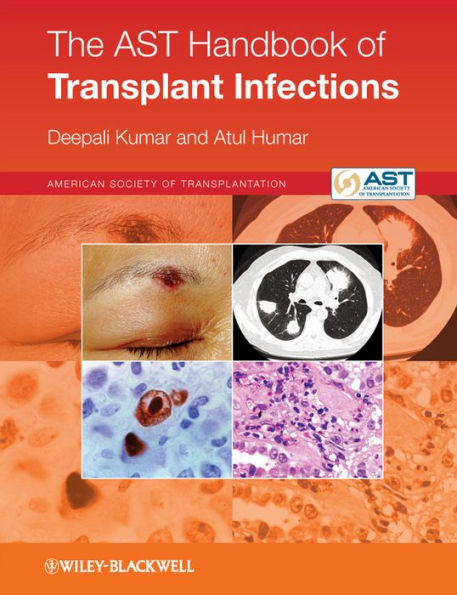

Overview
This distinguished group of investigators and teachers provide point of care information on optimum management of infection in adult and pediatric organ and stem cell transplant patients. The unique tables and flowcharts are devised by the authors, backed up with extensive references, making the book a fully researched yet easy to use guide.
The fast growing specialty of transplantation will be well served by this book as increasing numbers of successful procedures mean transplant teams have to be ever more alert to the possibility of and need for action in the event of ensuing infection.

Product Details
| ISBN-13: | 9781444397932 |
|---|---|
| Publisher: | Wiley |
| Publication date: | 04/18/2011 |
| Sold by: | JOHN WILEY & SONS |
| Format: | eBook |
| Pages: | 192 |
| File size: | 18 MB |
| Note: | This product may take a few minutes to download. |
About the Author
Atul Humar, MD, MSc, FRCPC, University of Alberta, Canada
Read an Excerpt
Table of Contents
SECTION A: General Issues and Infectious SyndromesFigure 1 Timeline of infections after Organ Transplant
Figure 2 Timeline of Infections after Hematopoietic Stem Cell Transplant
Figure 3 Immune Reconstitution after Myeloablative Stem Cell Transplant
Table 1 Pre-transplant Infectious Disease Evaluation of the Organ Transplant Candidate
Table 2 Infectious Disease Evaluation of the Hematopoietic Stem Cell Transplant (HSCT) Candidate
Figure 4A Anastomoses and Potential technical complications associated with either a pancreas transplant or kidney transplant
Figure 4B Anastomoses and potential technical complications associated with liver transplantation
Figure 4C Right lobe living donor liver transplant: anastomoses and selected technical complications
Table 3 Right lobe living donor liver transplant: anastomoses and selected technical complications
Table 4 Infections in kidney transplant recipients
Table 5 Infections in pancreas transplant recipients
Table 6 Infections in liver transplant recipients
Table 7 Management of infections in Lung, Heart-Lung, and Heart Transplant Recipients
Table 8 Infections in Intestinal transplant recipients
Table 9A Stepwise Approach to Empiric Antimicrobial Therapy in Febrile Neutropenia
Table 9B Agents for Empiric Antifungal Therapy in Febrile Neutropenics
SECTION B: Specific Pathogens
Table 10A Prevention of Cytomegalovirus Disease in Solid Organ Transplant Recipients
Table 10B Interpretation of Pediatric CMV serology in donors and recipients 18 months
Figure 5A Algorithm for Pre-emptive Therapy of CMV
Table 10C Treatment of CMV Infection and Disease in Solid Organ Transplant Recipients
Figure 5B Suggested algorithm for the management of ganciclovir-resistant CMV infection and disease
Figure 6 Prevention of EBV-related PTLD after Transplant
Table 11A Interpretation of Pediatric EBV serology in donors and recipients 18 months
Table 11B Treatment of PTLD after Transplantation
Table 12 Management of Herpes Simplex Virus (HSV)
Table 13 Management of Varicella Zoster Virus
Table 14 Prevention and Treatment of Human Herpesvirus 6, 7 and 8 Infections in Transplant Recipients
Table 15A Screening, diagnosis and Intervention for PyVAN after renal transplantation
Table 15B Screening for BKV replication in Kidney Transplant Recipients
Table 15C Screening for BKV replication and PyVAN in Non-Kidney Solid Organ Transplant Recipients
Table 15D Treatment of BKV Viremia or PyVAN by modification of maintenance immunosuppression
Table 16A Prevention and treatment of respiratory viral infections after transplantation
Table 16B Prevention and treatment of influenza after transplantation
Figure 7A Treatment of Hand or Plantar (Cutaneous) Warts after Transplantation
Figure 7B Treatment of External Anogenital Warts after Transplantation
Table 17A Hepatitis B Management in HBsAg Positive Recipients
Table 17B Hepatitis B Management in HBcAb Positive, HBsAg Negative, HBsAb Positive or Negative Recipients
Table 18 Hepatitis C Management in Transplant Candidates and Recipients
Table 19A Initial Pre-Transplant Evaluation of Patients with HIV
Table 19B HIV-Patient Selection Criteria for Transplantation
Table 19C Preferred Antiretroviral Drugs in HIV+ Transplant Candidates or Recipients
Table 19D Drug-Drug Interactions and Post-transplant Management in Transplanted Patients with HIV
Table 20 Fungal infection: Prevention and therapy
Table 21 Treatment of Nocardia Infections
Table 22A Treatment of latent Mycobacterium tuberculosis (TB) infection
Table 22B Treatment of active Mycobacterium tuberculosis infection
Table 23 Treatment of nontuberculous Mycobacterium (NTM) infections
Table 24 Pneumocystis jiroveci pneumonia Prophylaxis and Therapy
Table 25 Suggested therapy of Clostridium difficile colitis after Transplantation
Table 26 Diagnosis and Treatment of Multidrug Resistant Bacteria
Table 27 Management of Selected Parasitic Infections after Transplant
SECTION C: Donor Issues
Table 28 Infectious Disease Evaluation of the Potential Organ Donor
Table 29 Infectious Disease Evaluation of the Potential Hematopoietic Stem Cell Transplant (HSCT) Donor
Table 30A Potential Infections that May be Transmitted from Donor to Recipient
Table 30B Potential Infections that May be Transmitted from Donor to Recipient
Table 31 Estimates of Window Period Length for Serology and Nucleic Acid Testing (NAT)
Table 32 Estimates of residual risk of HIV or HCV when using selected increased risk donor categories
Figure 8 Management of Recipients of Hepatitis B Core Antibody Positive Donor Organ
Table 33 Donor Tuberculosis Issues: Potential Scenarios and Management
SECTION D: Prevention of Infections after Transplantation
Table 34 Suggested Prophylaxis Regimens in organ transplant recipients
Table 35A Antimicrobial Prophylaxis Regimen for Allogeneic HSCT Recipients
Table 35B Antimicrobial Prophylaxis Regimen for Autologous HSCT Recipients
Table 36 Adult Vaccination Schedule post-Solid Organ Transplantation
Table 37 Adult Vaccination Schedule post-Allogeneic Stem Cell Transplant
Table 38 Immunizations post-pediatric SOT and HSCT
Table 39 Travel-related Recommendations after transplant
Table 40 Safe living strategies for transplant patients
SECTION E: Post-transplant Medications and Drug Interactions
Table 41 Common Immunosuppressive Drugs, Mechanisms of Action, Side Effects, and other Interactions
Table 42 Infectious Risks associated with monoclonal antibodies
Table 43 Drug interactions between antimicrobial agents and common immunosuppressive drugs used in transplantation
Table 44 Antiviral Agents for Adult Transplant Recipients
Table 45 Antifungal Agents in Adult Transplant Recipients
Table 46A Antiviral agents for Pediatric Transplant Recipients
Table 46B Antifungal agents for Pediatric Transplant Recipients ?
What People are Saying About This
"Overall, I enjoyed this book and its contribution to the field of transplantation. Many clinicians would find this helpful in their daily practice." (Doody's, 16 December 2011)
